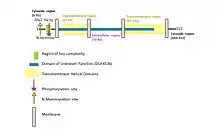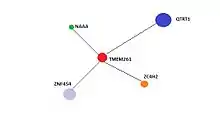DMAC1
Transmembrane protein 261 is a protein that in humans is encoded by the TMEM261 gene located on chromosome 9.[2] TMEM261 is also known as C9ORF123 and DMAC1, Chromosome 9 Open Reading Frame 123 and Transmembrane Protein C9orf123[3] and Distal membrane-arm assembly complex protein 1.[4]
| Dmac1 | |||||||||||||||||||||||||||||||||||||||||||||||||||
|---|---|---|---|---|---|---|---|---|---|---|---|---|---|---|---|---|---|---|---|---|---|---|---|---|---|---|---|---|---|---|---|---|---|---|---|---|---|---|---|---|---|---|---|---|---|---|---|---|---|---|---|
| Identifiers | |||||||||||||||||||||||||||||||||||||||||||||||||||
| Aliases | Tmem2611700027K24Rik3110001D03Riktransmembrane protein 261distal membrane arm assembly complex 1 | ||||||||||||||||||||||||||||||||||||||||||||||||||
| External IDs | HomoloGene: 12054 GeneCards: | ||||||||||||||||||||||||||||||||||||||||||||||||||
| |||||||||||||||||||||||||||||||||||||||||||||||||||
| |||||||||||||||||||||||||||||||||||||||||||||||||||
| |||||||||||||||||||||||||||||||||||||||||||||||||||
| |||||||||||||||||||||||||||||||||||||||||||||||||||
| Wikidata | |||||||||||||||||||||||||||||||||||||||||||||||||||
| |||||||||||||||||||||||||||||||||||||||||||||||||||
Gene features
TMEM261 is located at 9p24.1, its length is 91,891 base pairs (bp) on the reverse strand.[3] Its neighbouring gene is PTPRD located at 9p23-p24.3 also on the reverse strand and encodes protein tyrosine phosphatase receptor type delta.[2][3] TMEM261 has 2 exons and 1 intron, and 6 primary transcript variants; the largest mRNA transcript variant consisting of 742bp with a protein 129 amino acids (aa) in length and 13,500 Daltons (Da) in size, and the smallest coding transcript variant being 381bp with a protein 69aa long and 6,100 Da in size.[5][6]

Protein features
TMEM261 is a protein consisting out of 112 amino acids, with a molecular weight of 11.8 kDa.[7] The isoelectric point is predicted to be 10.2,[8] whilst its posttranslational modification value is 9.9.[6]
Structure

TMEM261 contains a domain of unknown function, DUF4536 (pfam15055), predicted as a helical membrane spanning domain about 45aa (Cys 47- Ser 92) in length with no known domain relationships.[9][10] Two further transmembrane helical domains are predicted of lengths 18aa (Val 52-Ala 69) and 23aa (Pro 81-Ala 102]).[11][12] There is also a low complexity region spanning 25aa (Thr 14-Ala 39).[13] The tertiary structure for TMEM261 has not yet been determined. However, its protein secondary structure is mostly composed of coiled-coil regions with beta strands and alpha helices found within the transmembrane and domain of unknown function regions. The N-terminal region of TMEM261 is composed of a disordered region[14][15] which contains the low complexity region[13] that is not highly conserved amongst orthologues.[16][17]
Modifications
A N-myristoylation domain is shown to be present in most TMEM261 protein variants.[6] Post-translational modifications include myristoylation of the N-terminal Glycine residue (Gly2)[6][18] of the TMEM261 protein as well as phosphorylation of Threonine 31.[19]
Interactions
Proteins shown to interact with TMEM261 include NAAA (protein-protein interaction), QTRT1 (RNA-protein interaction),ZC4H2(DNA-protein interaction)[20] and ZNF454(DNA-protein interaction).[21][22] It has also shown to interact with APP(protein-protein interaction),[23] ARHGEF38(protein-protein interaction)[24] and HNRNPD(RNA-protein interaction).[25][26]

Additional transcription factor binding sites (DNA-protein interaction) predicted include one binding site for MEF2C a monocyte-specific enhancement factor that is involved in muscle-cell regulation particularly in the cardiovascular system[3][28] and two binding sites for GATA1 which is a globin transcription factor 1 involved in erythroblast development regulation.[29][30][31]
Expression
TMEM261 shows ubiquitous expression in humans and is detected in almost all tissue types.[32][33] It shows tissue-enriched gene (TEG) expression when compared to housekeeping gene (HKG) expression.[27] Its highest expression is seen in the heart (overall relative expression 94%) particularly in heart fibroblast cells, thymus (overall relative expression 90%), and thyroid (overall relative expression 93%) particularly in thyroid glandular cells.[27][32] Staining intensity of cancer cells showed intermediate to high expression in breast, colorectal, ovarian, skin, urothelial, head and neck cells.[32]
Function
Currently the function for TMEM261 is unknown.[34] However, gene amplification and rearrangements of its locus have been associated with various cancers including colorectal cancer,[35] breast cancer[36] and lymphomas.[37][38]
Evolution
Orthologues
The orthologues and homologues of TMEM261 are limited to vertebrates, its oldest homologue dates to that of the cartilaginous fishes[39] which diverged from Homo sapiens 462.5 million years ago.[40] The protein primary structure of TMEM261 shows higher overall conservation in mammals, however high conservation of the domain of unknown function (DUF4536) to the C-terminus region is seen in all orthologues, including distant homologues. The protein structure of TMEM261 shows conservation across most orthologues.[16][17]
| Organism | Scientific Name | Accession Number | Date of Divergence from Humans (million years) | Amino acids (aa) | Identity (%) | Class |
|---|---|---|---|---|---|---|
| Humans | Homo sapiens | NP_219500.1 | 0 | 112 | 100 | Mammalia |
| Gorilla | Gorilla gorilla | XP_004047847.1 | 8.8 | 112 | 99 | Mammalia |
| Olive baboon | Papio anubis | XP_003911767.1 | 29 | 112 | 84 | Mammalia |
| Sunda flying lemur | Galeopterus variegatus | XP_008587957.1 | 81.5 | 112 | 68 | Mammalia |
| Lesser Egyptian jerboa | Jaculus Jaculus | XP_004653029.1 | 92.3 | 109 | 56 | Mammalia |
| Naked mole rat | Heterocephalus glaber | XP_004898193.1 | 92.3 | 114 | 45 | Mammalia |
| White rhinoceros | Ceratotherium simum simum | XP_004436891.1 | 94.2 | 112 | 66 | Mammalia |
| Nine-banded armadillo | Dasypus novemcinctus | XP_004459147.1 | 104.4 | 112 | 59 | Mammalia |
| Green sea turtle | Chelonia mydas | XP_007056940.1 | 296 | 85 | 49 | Reptilia |
| Zebra finch | Taeniopygia Guttata | XP_002187613.2 | 296 | 72 | 47 | Aves |
| Western clawed frog | Xenopus tropicalis | XP_002943025.1 | 371.2 | 85 | 45 | Amphibia |
| Haplochromis burtoni | Haplochromis burtoni | XP_005928614.1 | 400.1 | 91 | 51 | Actinopterygii |
| Australian ghost shark | Callorhinchus milii | XP_007884223.1 | 426.5 | 86 | 43 | Chondrichthyes |
Paralogues
TMEM261 has no known paralogs.[39]
References
- "Human PubMed Reference:". National Center for Biotechnology Information, U.S. National Library of Medicine.
- "Entrez Protein: TMEM261".
- "GeneCards: PTPRD".
- "DMAC1 - Distal membrane-arm assembly complex protein 1 - Homo sapiens (Human) - DMAC1 gene & protein". www.uniprot.org. Retrieved 2018-07-30.
- Thierry-Mieg, D; Thierry-Mieg, J. (2006). "AceView: a comprehensive cDNA-supported gene and transcripts annotation". Genome Biology. 7 (Suppl 1): S12.1–14. doi:10.1186/gb-2006-7-s1-s12. PMC 1810549. PMID 16925834.
- "AceView:Homo sapiens gene C9orf123".
- "Ensemble:Transcript TMEM261-003".
- "PI:Isoelectric point determination".
- "NCBI Conserved Domains: DUF4536".
- "EMBL-EBI Interpro: Transmembrane protein 261 (Q96GE9)".
- "Phobius: A combined transmembrane topology and signal peptide predictor".
- "Q96GE9 - TM261_HUMAN". UniProt. UniProt Consortium.
- "Vega: Transcript: C9orf123-003".
- "PHYRE: Protein Homology/analogY Recognition Engine". PHYRE.
- Kelley, LA; Sternberg, MJE (2009). "Protein structure prediction on the Web: a case study using the Phyre server". Nature Protocols. 4 (3): 363–371. doi:10.1038/nprot.2009.2. hdl:10044/1/18157. PMID 19247286. S2CID 12497300.
- "ClustalW".
- Thompson, Julie D; Higgins, Desmond G; Gibson, Toby J (1994). "CLUSTAL W: improving the sensitivity of progressive multiple sequence alignment through sequence weighting, position-specific gap penalties and weight matrix choice". Nucleic Acids Res. 22 (22): 4673–4680. doi:10.1093/nar/22.22.4673. PMC 308517. PMID 7984417.
- Gallo, Vincenzo. "Myristoylation : Proteins Post-translational Modifications". flipper.diff.org. University of Turin.
- "Nextprot:TMEM261 » Transmembrane protein 261".
- Dash A, et al. (2002). "Changes in differential gene expression because of warm ischemia time of radical prostatectomy specimens". Am J Pathol. 161 (5): 1743–1748. doi:10.1016/S0002-9440(10)64451-3. PMC 1850797. PMID 12414521.
- Rovillain E, et al. (2011). "An RNA interference screen for identifying downstream effectors of the p53 and pRB tumour suppressor pathways involved in senescence". BMC Genomics. 12 (355): 355. doi:10.1186/1471-2164-12-355. PMC 3161017. PMID 21740549.
- "c9orf123 protein (Homo Sapiens)- STRING Network View". STRING - Known and Predicted Protein-Protein Interactions.
- Oláh J, et al. (2011). "Interactions of pathological hallmark proteins: tubulin polymerization promoting protein/p25, beta-amyloid, and alpha-synuclein". J Biol Chem. 286 (39): 34088–34100. doi:10.1074/jbc.M111.243907. PMC 3190826. PMID 21832049.
- Huttlin EL, et al. (2014). "High-Throughput Proteomic Mapping of Human Interaction Networks via Affinity-Purification Mass Spectrometry (Pre-Publication)". Pre-Publication.
- Lehner, B; Sanderson, C M (2004). "A protein interaction framework for human mRNA degradation". Genome Res. 14 (7): 1315–1323. doi:10.1101/gr.2122004. PMC 442147. PMID 15231747.
- "9ORF123 chromosome 9 open reading frame 123". BioGRID: Database of Protein and Genetic Interactions. TyersLab.
- She X, Rohl CA, Castle JC, Kulkarni AV, Johnson JM, Chen R (2009). "Definition, conservation and epigenetics of housekeeping and tissue-enriched genes". BMC Genomics. 10: 269. doi:10.1186/1471-2164-10-269. PMC 2706266. PMID 19534766.
- "GeneCards:MEF2C Gene".
- Welch JJ, et al. (2004). "Global regulation of erythroid gene expression by transcription factor GATA-1". Blood. 104 (10): 3136–3147. doi:10.1182/blood-2004-04-1603. PMID 15297311.
- Merryweather-Clarke AT, et al. (2011). "Global gene expression analysis of human erythroid progenitors". Blood. 117 (13): e96-108. doi:10.1182/blood-2010-07-290825. PMID 21270440.
- "Genomatics- NGS Data Analysis and Personalised Medicine". Genomatix. Genomatix Software GmbH.
- "The Human Protein Atlas:TMEM261".
- "EST profile: TMEM261". UniGene. National Library of Medicine.
- Wu J, et al. (2012). "Identification and functional analysis of 9p24 amplified genes in human breast cancer". Oncogene. 31 (3): 333–341. doi:10.1038/onc.2011.227. PMC 3886828. PMID 21666724.
- Gaspar, C (2008). "Cross-Species Comparison of Human and Mouse Intestinal Polyps Reveals Conserved Mechanisms in Adenomatous Polyposis Coli (APC)-Driven Tumorigenesis". Am J Pathol. 172 (5): 1363–1380. doi:10.2353/ajpath.2008.070851. PMC 2329845. PMID 18403596.
- Wu, J (2012). "Identification and functional analysis of 9p24 amplified genes in human breast cancer". Oncogene. 31 (3): 333–341. doi:10.1038/onc.2011.227. PMC 3886828. PMID 21666724.
- Twa DD, et al. (2014). "Genomic Rearrangements Involving Programmed Death Ligands Are Recurrent in Primary Mediastinal Large B-Cell Lymphoma". Blood. 123 (13): 2062–2065. doi:10.1182/blood-2013-10-535443. PMID 24497532.
- Green MR, et al. (2010). "Integrative Analysis Reveals Selective 9p24.1 Amplification, Increased PD-1 Ligand Expression, and Further Induction via JAK2 in Nodular Sclerosing Hodgkin Lymphoma and Primary Mediastinal Large B-Cell Lymphoma". Blood. 116 (17): 3268–3277. doi:10.1182/blood-2010-05-282780. PMC 2995356. PMID 20628145.
- "NCBI BLAST:Basic Local Alignment Search Tool".
- Hedges, S. Blaire; Dudley, Joel; Kumar, Sudhir (22 September 2006). "TimeTree: a public knowledge-base of divergence times among organisms" (PDF). Bioinformatics. 22 (23): 2971–2972. doi:10.1093/bioinformatics/btl505. PMID 17021158. Archived from the original (PDF) on 5 May 2015. Retrieved 7 May 2015.
External links
Further reading
- Nicholas K. Tonks (2006). "Protein tyrosine phosphatases: from genes, to function, to disease". Cancer Cell. 7 (11): 833–846. doi:10.1038/nrm2039. PMID 17057753. S2CID 1302726.
- Merryweather-Clarke AT, et al. (2011). "Global gene expression analysis of human erythroid progenitors" (PDF). Blood. 117 (13): e96-108. doi:10.1182/blood-2010-07-290825. PMID 21270440. S2CID 1021801.
- Welch JJ, Watts JA, Vakoc CR, et al. (2004). "Global regulation of erythroid gene expression by transcription factor GATA-1". Blood. 104 (10): 3136–3147. doi:10.1182/blood-2004-04-1603. PMID 15297311.
- Nickeleit I, et al. (2008). "Argyrin a reveals a critical role for the tumor suppressor protein p27(kip1) in mediating antitumor activities in response to proteasome inhibition". Cancer Cell. 14 (1): 23–35. doi:10.1016/j.ccr.2008.05.016. hdl:11858/00-001M-0000-0012-DB83-6. PMID 18598941.

